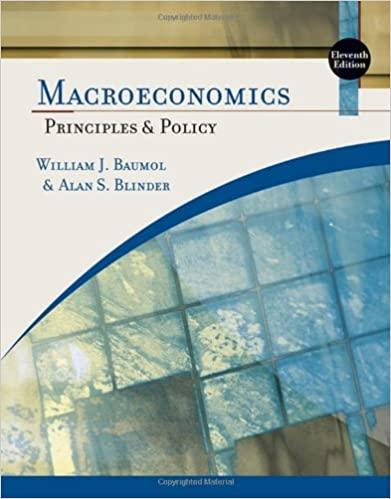Answered step by step
Verified Expert Solution
Question
1 Approved Answer
Multiple choice Q.1.1 An increase in the budget deficit is the result of: (2 (a) Expansionary monetary policy; (b) Contractionary monetary policy; (c) Expansionary fiscal
Multiple choice Q.1.1 An increase in the budget deficit is the result of: (2 (a) Expansionary monetary policy; (b) Contractionary monetary policy; (c) Expansionary fiscal policy; (d) Contractionary fiscal policy. Q.1.2 Company tax is a: (2) (a) Progressive, direct tax; (b) Progressive, indirect tax; (c) Proportional direct tax; (d) Regressive indirect tax. Q.1.3 In the base year, a country produced 50 units of output at a price of R6,00 each for a nominal GDP of R300. This year it produces 60 units of output at a price of R8,00 each. What is the percentage change in real GDP since the base year? (a) 5%; (b) 10%; (c) 20%; (d) 15%. Q.1.4 Which of the following statements about Fiscal Policy is INCORRECT? (a) In order to combat inflation, the South African Reserve Bank must apply a contractionary fiscal policy; (b) A contractionary fiscal policy can result in higher levels of unemployment; (c) Expansionary fiscal policy will increase the budget deficit; (d) The application of fiscal policy will have no effect on aggregate supply in the ADAS model. Q.1.5 If the inflation rate is 6% and Susan receives a 6% increase in income, then, over the year, Susan's: (a) Real and nominal income both remain unchanged; (b) Real and nominal income both rise; (c) Real income rises but nominal income remains unchanged; (d) Nominal income rises but real income remains unchanged. Q.1.6 Given the import function, Z = 300 + 2/3Y, which of the following statements is correct? (a) The marginal propensity to save is 1/3; (b) The induced component is 300; (c) 2/3 is the proportion of any income spent on imports; (d) None of the statements is correct. Q.1.7 An increase of R5 billion in income in a macroeconomy leads to an increase in R3 billion in consumption spending. From this information, we can determine that the marginal propensity to save in this economy is: (a) 0.6; (b) 0.5; (c) 0.3; (d) 0.4. Q.1.8 Mr Brown has recently been retrenched. The firm he worked for had to retrench a number of staff due to the downturn in the economy. Mr Brown has not managed to find alternative employment. We can say he is _________________ unemployed. (a) Structurally; (b) Cyclically; (c) Seasonally; (d) Frictionally. Q.1.9 If the CPI was 106 in 2013 and 116 in 2014, the inflation rate in 2014 was: (a) 106%; (b) 116%; (c) 9.4%; (d) 16% Q.1.10 Strikes across a wide range of industries in South Africa in the first half of 2020 can be illustrated in the ADAS model as a: (a) Leftward shift of the AD curve; (b) Rightward shift of the AD curve; (c) Leftward shift of the AS curve; (d) Rightward shift of the AS curve
Step by Step Solution
There are 3 Steps involved in it
Step: 1

Get Instant Access to Expert-Tailored Solutions
See step-by-step solutions with expert insights and AI powered tools for academic success
Step: 2

Step: 3

Ace Your Homework with AI
Get the answers you need in no time with our AI-driven, step-by-step assistance
Get Started


